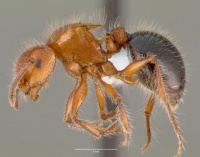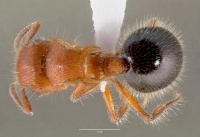Meranoplus mayri
| Meranoplus mayri | |
|---|---|

| |
| Scientific classification | |
| Kingdom: | Animalia |
| Phylum: | Arthropoda |
| Class: | Insecta |
| Order: | Hymenoptera |
| Family: | Formicidae |
| Subfamily: | Myrmicinae |
| Tribe: | Crematogastrini |
| Genus: | Meranoplus |
| Species: | M. mayri |
| Binomial name | |
| Meranoplus mayri Forel, 1910 | |
Meranoplus mayri is distributed throughout the drier regions of Madagascar from the Southwestern region near P.N. Andohahela all the way north into the Mahajanga province. The elevational range of M. mayri is 20–1345 m. Unfortunately, as with most of the diversity of Meranoplus, nothing is known about the behavior or ecology of M. mayri except that its ground nests may be found in urban gardens, grasslands, and deciduous and spiny forests. This is the most frequently collected Malagasy Meranoplus, with numerous specimens captured in pitfalls, malaise traps, and hand collections. Although few collections have been made of this species in the High Plateau region, it is predicted that they may be found there as well. (Boudinot & Fisher, 2013.)
Identification
Boudinot and Fisher (2013) - Worker. Each of the following characters is sufficient to uniquely identify this species in the Malagasy fauna: long posterolateral promesonotal spines; conelike clypeal denticles; longitudinally costate face and pleurae; concentric arcing costae on promesonotal shield; fourth abdominal tergum dense-punctate; head broader than long (CI > 100); malar space about twice as long as eye (OMI 44–61); clypeal denticles widely set (CDI > 40). The labrum of M. mayri is distinct from the labra of Meranoplus radamae and Meranoplus sylvarius. The labral lobes in M. mayri are evenly rounded distally, whereas those of M. radamae and sylvarius are evenly rounded apicolaterally and taper linearly to the midline. Gyne. Each of the following characters is sufficient to uniquely identify this species in the Malagasy fauna: large (WL > 1.90); face longitudinally costate; head broader than long (CI > 102); eyes small (EYE < 39); eye length distinctly less than ¾ malar area length (OMI < 61). Male. The large size (WL 1.6–1.9) and raised posterior margin of the head uniquely identify this species in the Malagasy fauna. Diagnosis is supported by the following characters: umbilicate setiferous punctures present on head and mesosomal dorsum; eyes comparatively small (EYE 62–66); eyes less than 2.5 times as long as the malar area (OMI 212–243); posteroventral apex of penisvalva produced beyond posterodorsal margin; penisvalva without apical lobe.
This species displays subtle variation in morphometric and most sculptural characters across its range except for the sculpture of the base of abdominal tergum IV. This character varies from extremely smooth and shining in the southwest to strongly, dense-punctate and costate along the western edge of the High Plateau.
Keys including this Species
Distribution
Latitudinal Distribution Pattern
Latitudinal Range: -15.71° to -25.6°.
| North Temperate |
North Subtropical |
Tropical | South Subtropical |
South Temperate |
- Source: AntMaps
Distribution based on Regional Taxon Lists
Malagasy Region: Madagascar (type locality).
Distribution based on AntMaps
Distribution based on AntWeb specimens
Check data from AntWeb
Countries Occupied
| Number of countries occupied by this species based on AntWiki Regional Taxon Lists. In general, fewer countries occupied indicates a narrower range, while more countries indicates a more widespread species. |

|
Estimated Abundance
| Relative abundance based on number of AntMaps records per species (this species within the purple bar). Fewer records (to the left) indicates a less abundant/encountered species while more records (to the right) indicates more abundant/encountered species. |

|
Habitat
Meranoplus mayri is distributed throughout the drier regions of Madagascar from the Southwestern region near P.N. Andohahela all the way north into the Mahajanga province. The elevational range of M. mayri is 20–1345 m.
Biology
Castes
Images from AntWeb
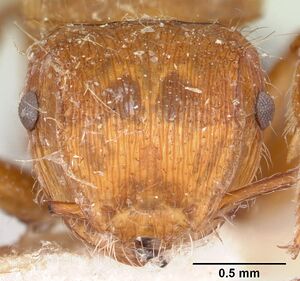   
| |
| Worker. Specimen code casent0101231. Photographer April Nobile, uploaded by California Academy of Sciences. | Owned by MHNG, Geneva, Switzerland. |
   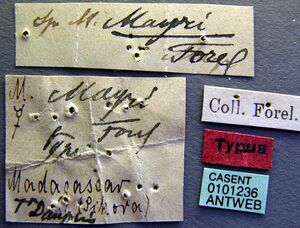
| |
| Worker. Specimen code casent0101236. Photographer Nick Olgeirson, uploaded by California Academy of Sciences. | Owned by MHNG, Geneva, Switzerland. |
  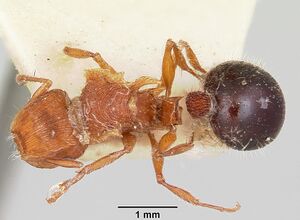 
| |
| Worker. Specimen code casent0101237. Photographer April Nobile, uploaded by California Academy of Sciences. | Owned by MHNG, Geneva, Switzerland. |
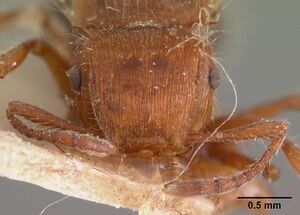 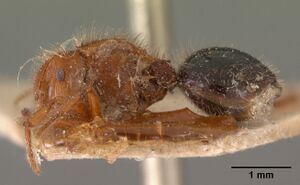  
| |
| Worker. Specimen code casent0102067. Photographer April Nobile, uploaded by California Academy of Sciences. | Owned by MSNG, Genoa, Italy. |
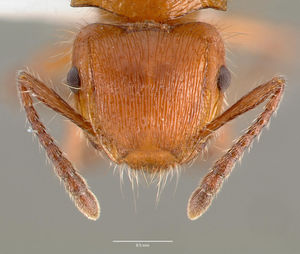 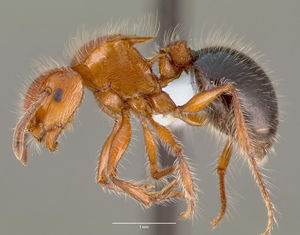 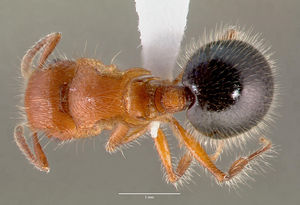 
| |
| Worker. Specimen code casent0430421. Photographer April Nobile, uploaded by California Academy of Sciences. | Owned by CAS, San Francisco, CA, USA. |
Images from AntWeb
   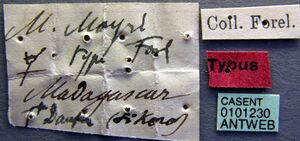
| |
| Lectotype of Meranoplus mayri. Worker. Specimen code casent0101230. Photographer Nick Olgeirson, uploaded by California Academy of Sciences. | Owned by MHNG, Geneva, Switzerland. |
Nomenclature
The following information is derived from Barry Bolton's Online Catalogue of the Ants of the World.
- mayri. Meranoplus mayri Forel, 1910a: 19 (w.) MADAGASCAR.
- Type-material: lectotype worker (by designation of Boudinot & Fisher, 2013: 320).
- [Note: unrecorded paralectotypes are probably present in MHNG and elsewhere as Forel certainly had several original syntypes.]
- Type-locality: Madagascar: Fort Dauphin (Sikora).
- Type-depository: MHNG.
- Boudinot & Fisher, 2013: 321 (q.m.).
- Status as species: Wheeler, W.M. 1922a: 1029; Emery, 1924d: 227; Bolton, 1995b: 251; Boudinot & Fisher, 2013: 320 (redescription).
- Distribution: Madagascar.
Unless otherwise noted the text for the remainder of this section is reported from the publication that includes the original description.
Description
Boudinot and Fisher (2013):
Worker
HL 0.93–1.27, HW 0.98–1.41, HLA 0.34–0.54, CW 0.37–0.49, CDD 0.17–0.25, SL 0.74–1.04, EL 0.18–0.26, EW 0.15–0.19, PML 1.06–1.53, PWA 0.90–1.45, PWP 0.53–0.99, SPL 0.27–0.47, WL 1.04–1.58, PTL 0.18–0.35, PTH 0.43–0.61, PPL 0.24–0.40, PPH 0.39–0.58, ATW 1.03–1.77, ATL 1.09–1.82, CI 100.4–111.8, SI 69.0–84.9, OMI 43.6–60.5, CDI 42.7–58.8, SEI 379–454, PMI 88.1–97.5, PWI 51.2–73.9, CS 0.9–1.3, EYE 30.0–35.3 (50 measured).
Bicolored; head, mesosoma, petiole and postpetiole orange, metasoma piceous to black.
Head as broad as or broader than long (CI > 100). Mandibles striate. Face with numerous (> 20) parallel costae which extend from the posterior margin of the clypeus to the posterior margin of the head; a few lateral costae curve posteriorly to the eye and either end at the eye or the base of the mandibles. Frontal carinae produced over the antennal scrobe as flanges, and with rugose sculpture on the dorsal surface. Scrobal carina dwarfed by the frontal carina flange, sometimes reduced to near absence. Anterior margin of clypeus without lamina; lateral corners of middle portion of clypeus produced into two stout, widely set denticles (CDI > 40). Middle portion of clypeus shining, with strong costae. Eyes small (EYE < 36). Maximum eye length less than ¾ length of malar area (OMI < 62). Face covered with numerous erect setae of various lengths; longest setae about 2.5 times as long as eye, and somewhat more frequent; shortest setae about equal in length to the eye.
Promesonotal shield longer than broad, including the posterolateral spines (PMI < 99). Lateral margins of promesonotal shield produced into translucent flanges. Anterolateral corners acute to subacute. Lateral flanges produced into flat denticles past midlength; these medial denticles are set off from rest of margin by anterior and posterior emarginations. Posterolateral spines dorsoventrally flattened; always longer than their base; sometimes depressed below the plane of the promesonotal dorsum; often parallel, sometimes curved medially. Promesonotal shield with arcing costae: the costae begin on the posterolateral spines or lateral flanges and curve anteriorly, with their vertices anterior to the medial denticles. Promesonotal shield with rugose sculpture on the lateral and posterior flanges as well as on the spines. Setae on promesonotal dorsum of similar composition to those of the face. Mesosomal pleurae without visible sutures. Lateral faces of mesosoma covered with numerous (> 15) longitudinal costae. Metapleural lobes weakly projecting posteriorly. Propodeal spines long (SPL mean 0.38); mediolaterally flattened; translucent. Posterior face of propodeum with strong to weak punctuation; with or without longitudinal costae.
Petiole without pedicel or lobe-like ventral process, but otherwise variable: with strong to weak anterolateral bulges; dorsal margin with well- to poorly-developed lamina; dorsolateral margins swept backward and produced into lobe-like laminae which may be long or short, rounded acute to obtuse, directed posterolaterally or dorsolaterally, with dense or dilute ventral pubescence. Postpetiole nodiform (PPI > 60). Dorsal face of postpetiole with strong rugose-areolate sculpture; lateral face strongly costate and rugose; posterior face rugose to areolate. Fourth abdominal tergum (ATIV) small (ATW/WL 1.20; ATL/WL < 1.23). ATIV with dense-punctate sculpture always in posterior half; anterior half grading from dense-punctate with radiating costae to smooth and shining with very weak costae. Setiferous punctures of ATIV surrounded by a circular area of shining, weak punctae. The majority of setae on ATIV longer than the maximum width of the metafemora; longest setae present around the base of abdominal tergum IV; setae decrease in length posteriorly.
Queen
HL 1.35–1.44, HW 1.48–1.58, HLA 0.48–0.54, CW 0.50–0.55, CDD 0.21–0.25, SL 0.96–1.07, EL 0.28–0.31, EW 0.23–0.24, SPL 0.19–0.25, WL 1.95–2.12, PTL 0.33–0.38, PTH 0.51–0.65, PPL 0.38–0.47, PPH 0.62–0.69, ATW 1.95–2.26, ATL 2.17–2.35, CI 105.8–113.3, SI 64.7–67.8, OMI 54.4–60.9, CDI 39.1–49.1, SEI 333–367, CS 1.4–1.5, EYE 34.6–37.1 (8 measured).
Bicolored; head, mesosoma, petiole and postpetiole orange, metasoma piceous to black.
Head broader than long (CI > 105). Mandibles striate. Face with numerous parallel costae, varying in rugosity, which extend from posterior margin of clypeus to posterior margin of head; lateralmost costae curving over eyes and extending to base of mandibles. Sculpture above the eyes costate to weakly rugose. Scrobal carina variable, never strong or bulging. Anterior margin of clypeus without lamina, rather with two strong, widely set, cone-shaped denticles (CDI > 38). Middle portion of clypeus entirely costate; costae of varying rugosity. Eyes comparatively small (EYE < 38). Maximum length of eye less than ¾ as long as malar area (OMI 54–61). Scapes not notably short (SI 64–68). Setae on face erect and of various lengths.
Mesosoma longer than tall. Anterolateral corners of pronotum produced into well-developed denticles; dorsolateral margin produced into a distinct carina. Mesosomal dorsum porcate; ridges of varying rugosity sometimes anastomosing. Setae on dorsum of mesosoma of various lengths; longest on the pronotum and mesoscutellum. Lateral face of pronotum costate, with costae in dorsal third curving upward to join dorsolateral carina. Katepisternum costate, occasionally with a smooth patch in anterior portion. Anepisternum with strong costae which are widely set relative to katepisternal costae. Mesopleuron and lateral face of propodeum costate. Propodeal spines variably short to long (SPL 0.14–0.25). Procoxae with distinct anterolateral basal shoulder. Procoxae with raised sculpture. Wings as in Meranoplus male diagnosis. Forewing discal cell 1 (d1) with marked intrapopulation variation: d1 longer than broad, or as long as broad; d1 posterodistal corner may be acute or sub-perpendicular.
Petiole cuneate in profile; with anterior bulge in ventral half; without pedicel. Anterolateral corners swept back, with laminar lobe variably developed. Postpetiole generally longer than tall, although exceptions may occur (PPI 64–69 [49]). Sternal process of postpetiole well-developed. Dorsal face of postpetiole strongly areolate-rugose; lateral face rugose-costate; posterior face rugose. Fourth abdominal tergum (ATIV) with sides convex in dorsal view. ATIV short (ATL/WL 1.16–1.09). Base of ATIV with weak to very strong dense-punctate sculpture; subparallel costae radiating from helcium strong to weak. Middle portion to posterior portion of ATIV always with dense-punctate sculpture; smooth around setiferous punctures. Majority of ATIV setae shorter than metafemora; setae longest at base of tergum.
Male
HL 0.75–0.92, HW 0.79–0.99, HLA 0.11–0.15, SL 0.23–0.30, EL 0.23–0.35, EW 0.23–0.28, WL 1.47–1.87, PTL 0.29–0.39 PTH 0.28–0.36, PPL 0.27–0.34, PPH 0.32–0.39, ATW 1.16–1.66, ATL 1.03–1.43, CI 105.3–112.6, SI 26.7–30.7, OMI 212–249, SEI 81–88, CS 0.8–1.0, EYE 61.6–65.5 (8 measured).
Body black, abdominal segments IV–VII brown to black above, appendages light to dark brown.
Large (WL 1.5–1.9, CS 0.8–1.0). Head broader than long (CI 105–113). Mandibles short and spatulate, otherwise variable: masticatory margin edentate, with one basal or apical tooth, or with two teeth; dentition sometimes variable between left and right mandibles of same specimen. Frontal carinae indistinct to obsolescent. In full face view, posterior margin of head raised above ocelli greater than distance between lateral ocelli. Head with fine areolate sculpture and variable costae: costae posterior to ocelli may be longitudinal or transverse. Scapes short (SI 27–31). Eyes comparatively small (EYE 62–66); about two-and-a-half to about two times as long as malar area (OMI 212–243). Ocelli about the size of antennal sockets. Setae of head set in umbilicate punctures. Majority of setae on body longer than eye-length, suberect to erect, sinuate.
Notauli distinct and set with foveae; may continue to posterior margin of scutum after converging. Parapsidal lines distinct, faintly impressed. All dorsal surfaces of mesosoma coarsely rugose, with umbilicate setiferous punctures which are especially strong anterolaterally on the scutum. Rugae on scutellum may be transverse or longitudinal. Mesopleuron roughened by evanescent longitudinal costae; anepisternum may be somewhat smooth and shining. Metapleuron and lateral face of propodeum costate. Posterior face of propodeum with curving costae. Wing venation as in Meranoplus male diagnosis.
Petiole and postpetiole shape variable (PTI 92–123, PPI 83–95). Petiole and postpetiole sessile; apex of petiolar node rounded; postpetiole subglobose. Petiolar sternum occasionally with setae. Post-petiolar sternum setose. Fourth abdominal tergum shining; generally with weak, fine areolate sculpture but occasionally smooth; setae set on nodules or in punctures. Petiole and post-petiolar sculpture variable, with or without costae or rugae; foveate. Fourth abdominal sternum subopaque, with fine areolation. Setae of fourth abdominal tergum set in simple punctures, which may be somewhat raised.
Foramen genitale constricted, diameter about ½ height of basal ring; basal ring broadening posteriorly; basimere about 1.33 times longer than tall in profile; weakly pigmented dorsally in posterior half; medioventral margin of basimere produced medially as a lamina; telomere base less than 0.5 times basimere height; volsella with an apicoventral denticle; setae of cuspis short, no longer than telomere setae; digitus broad, ribbonlike; apical third of digitus sharply bent ventrally at an angle somewhat greater than 90°. Ventral half of penisvalva apex produced posteriorly beyond apicodorsal margin lateral view; lateral apicodorsal margin somewhat angulate in dorsal view; valvura short, stout: broad at base with apex sub-rectangular. Ventral margin of penisvalva sinuate: convex in basal half to concave in distal half. Penisvalva ventral margin with long, recurved teeth; width and distance between the penisvalvar teeth varies basally to apically, with broadest, shortest teeth basally, increasing in size and spacing toward apex; spaces between teeth bases about half height of each tooth in apical third.
Type Material
Boudinot and Fisher (2013) - Meranoplus mayri Forel, 1910a: 19. Lectotype worker, here designated, MADAGASCAR: Toliara, Fort Dauphin, (Sikora) (Musee d'Histoire Naturelle Genève: CASENT0101230) [examined].
References
- Boudinot, B.E. & Fisher, B.L. 2013. A taxonomic revision of the Meranoplus F. Smith of Madagascar (Hymenoptera: Formicidae: Myrmicinae) with keys to species and diagnosis of the males. Zootaxa 3635, 301-339.
- Camacho, G.P., Loss, A.C., Fisher, B.L., Blaimer, B.B. 2021. Spatial phylogenomics of acrobat ants in Madagascar—Mountains function as cradles for recent diversity and endemism. Journal of Biogeography 48, 1706–1719 (doi:10.1111/jbi.14107).
- Fisher, B. L. 1997a. Biogeography and ecology of the ant fauna of Madagascar (Hymenoptera: Formicidae). J. Nat. Hist. 31: 269-302 (see also)
- Forel, A. 1910a. Glanures myrmécologiques. Ann. Soc. Entomol. Belg. 54: 6-32 (page 19, worker described)
- Jansen, G., Savolainen, R. 2010. Molecular phylogeny of the ant tribe Myrmicini (Hymenoptera: Formicidae). Zoological Journal of the Linnean Society 160(3), 482–495 (doi:10.1111/j.1096-3642.2009.00604.x).
- Wheeler, W. M. 1922k. Ants of the American Museum Congo expedition. A contribution to the myrmecology of Africa. IX. A synonymic list of the ants of the Malagasy region. Bull. Am. Mus. Nat. Hist. 4 45: 1005-1055 (see also)
References based on Global Ant Biodiversity Informatics
- Boudinot B. E.; Fisher, B. L. 2013. A taxonomic revision of the Meranoplus F. Smith of Madagascar (Hymenoptera: Formicidae: Myrmicinae) with keys to species and diagnosis of the males. Zootaxa 3635: 301-339
- Fisher B. L. 1997. Biogeography and ecology of the ant fauna of Madagascar (Hymenoptera: Formicidae). Journal of Natural History 31: 269-302.
- Fisher B. L. 2003. Formicidae, ants. Pp. 811-819 in: Goodman, S. M.; Benstead, J. P. (eds.) 2003. The natural history of Madagascar. Chicago: University of Chicago Press, xxi + 1709 pp.
- Wheeler W. M. 1922. Ants of the American Museum Congo expedition. A contribution to the myrmecology of Africa. IX. A synonymic list of the ants of the Malagasy region. Bulletin of the American Museum of Natural History 45: 1005-1055
